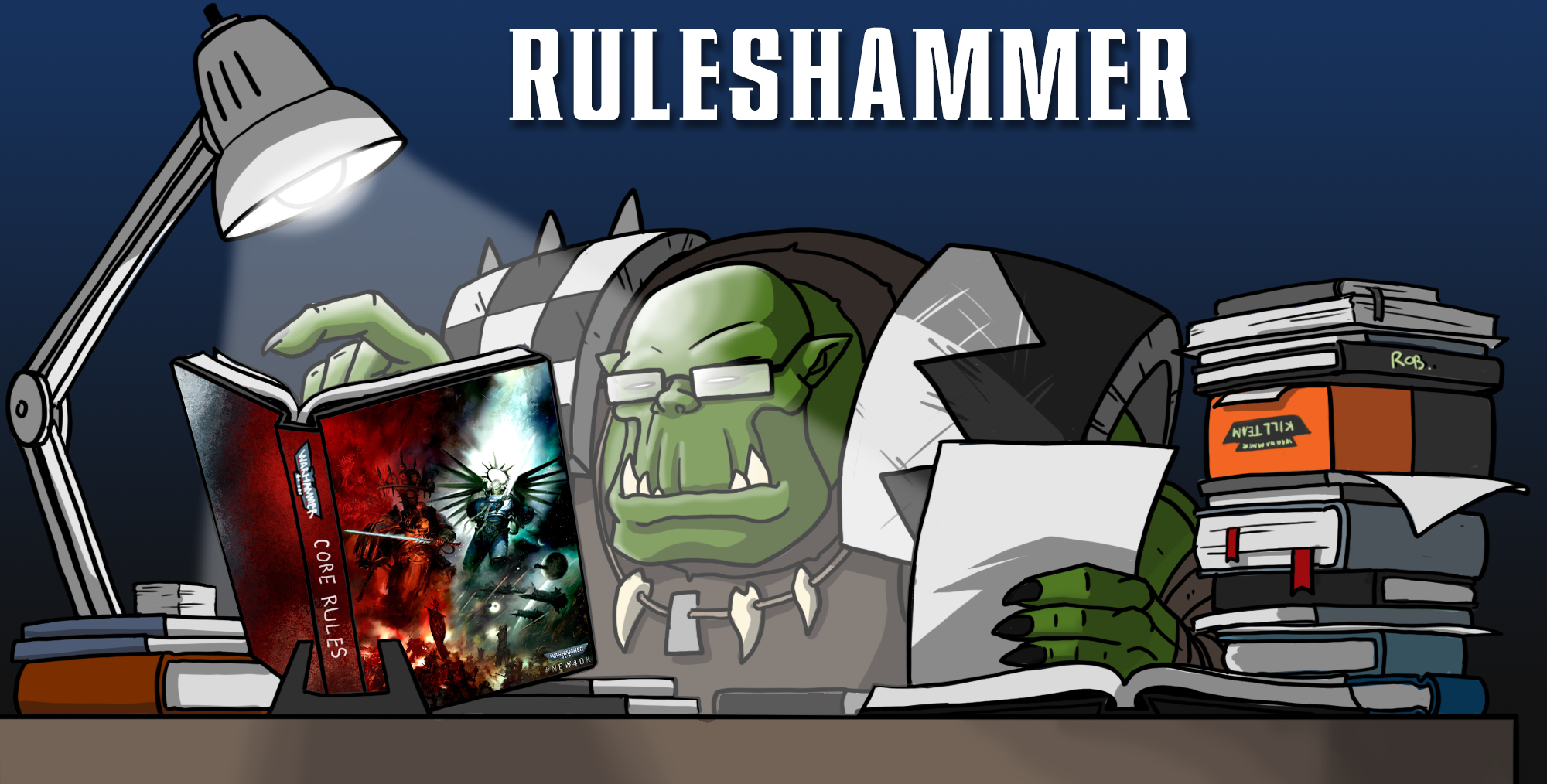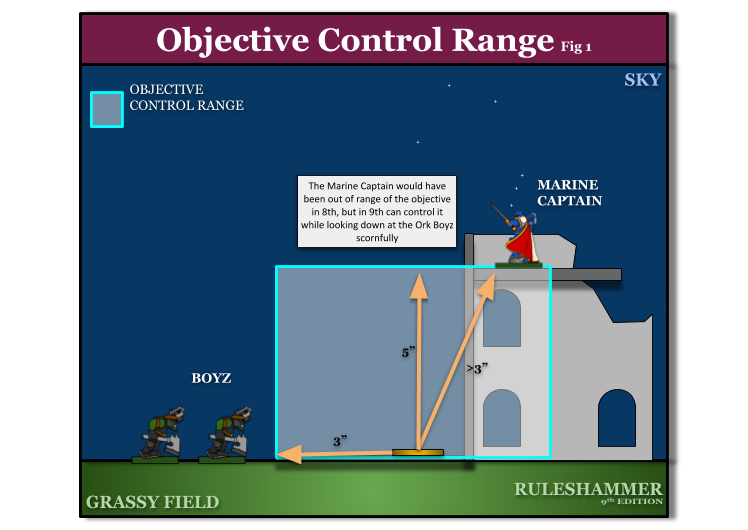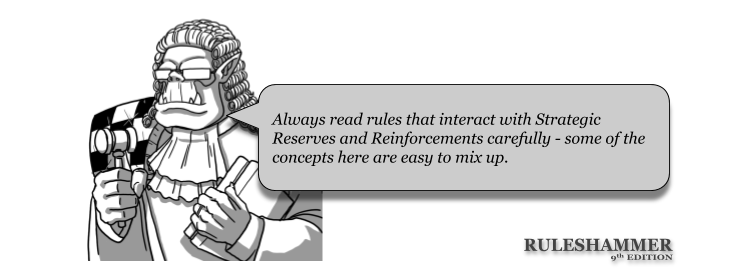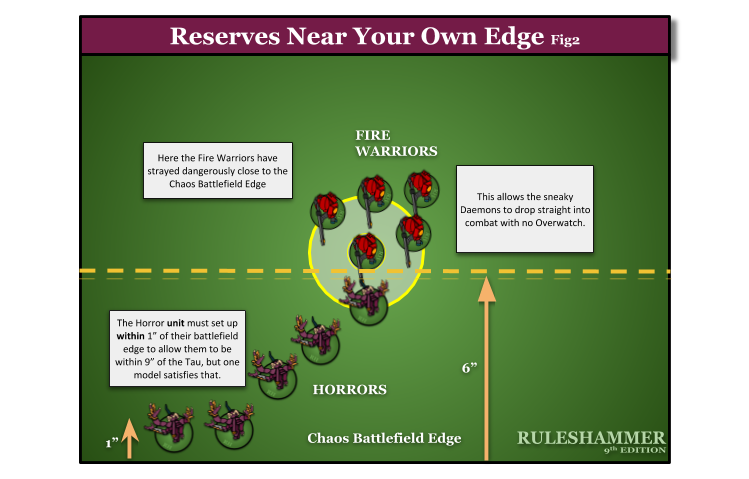With the new edition nearly upon us, we had Rob “Vre’kais” Chilton sit down with the new rulebook in the Indomitus boxed set and write his thoughts (in great detail) on the new rules – what’s changed, what needs clarification, and what you need to know. We’re in the home stretch now, with Wings looking at Strategic Reserves and Missions.
As well as substantially tidying up the process of deploying reserve units, as we saw in the movement phase, 9th massively extends the ability to set units up off the table with the addition of the Strategic Reserves rule, letting anything be held back at a price. Some of the rules for this also overlap directly with concepts added in the new missions, so today we’re looking at them together.
Missions
Mission Packs
All missions (except the introductory Only War mission) are sorted into Mission Packs. There are three of these in the main rulebook:
- Open Hostility (for Open Play)
- Eternal War (for Matched Play)
- Crusade (for Narrative Play)
Each mission pack consists of:
- A set of Mission Instructions, explaining how missions are played and scored.
- A set of Mission Briefings, outlining details of individual missions within the pack.
- Any other rules shared between the missions, such as Secondary Objectives and Agendas.
Mission Instructions
In line with 9th generally tidying up and tightening a lot of the rules, all missions packs now have a set of “Mission Instructions”. These provide a set of numbered steps that take you all the way through mustering an army, choosing a mission from the pack, setting up a table and playing the game. They also outline any general rules that apply to this set of missions.
It is very important to read these carefully for whichever mission set you are playing – the exact steps will differ based on the pack you are playing. These also outline the timing of some things that happen before the battle, such as declaring strategic reserves and other units that are using an ability to deploy as reinforcements.
Mission Objectives
All missions provide players with ways to score victory points, with the game’s winner usually being the player that accumulates the most of these during the game (with a few missions providing additional, alternate conditions). The Mission Instructions for a pack will tell you what kind of objectives are available for your mission. Narrative missions and Matched Play missions designate their objectives as one or both of “Progressive” or “End Game”.
…mission objectives can either be ‘End Game’ or ‘Progressive’. End Game mission objectives are scored at the end of the battle. Progressive mission objectives are scored during the battle (exactly when is detailed on the objective itself), and can be achieved and hence award victory points several times. [Book pg.283]
Note that while this quote says “either”, at least one objective is “Progressive and End Game”.
The Matched Play missions also introduce the concept of Primary and Secondary Objectives. Primary Objectives are fixed as part of the briefing for a mission, while Secondary Objectives are selected by each player before the battle from a list provided by the mission pack. Secondary Objectives contribute victory points to a player’s score.
The Crusade missions instead provide a list of Agendas. These are structured similarly to Secondary Objectives, but rather than providing Victory Points they instead contribute experience points to units that achieve them after the battle.
Mission Briefings
Within each mission pack, the Mission Instructions give you general rules, and Mission Briefings provide you with specific details for each of the missions within them. An example of a Mission Briefing is shown below.
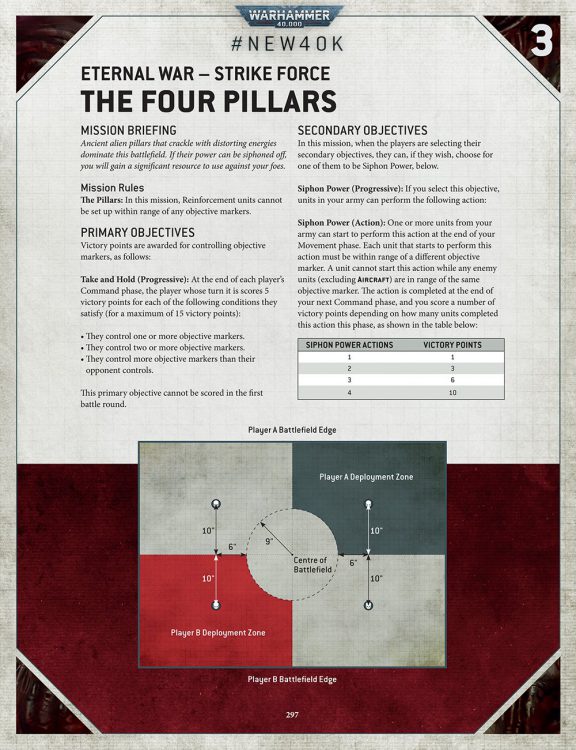
There are some key features shown here that represent changed or new concepts:
- All missions now have a fixed deployment map specific to that mission.
- As well as deployment zones, each player has a designated “Battlefield Edge”. This impacts on Strategic Reserves.
- Some missions packs have fixed objective placement, and if so, they will be shown in the mission briefing (as seen here). Other packs provide rules for players placing objectives.
- Some missions provide special rules that apply during them.
- Missions will provide details of their objectives. Here, details of both the Primary Objective and an additional option for a Secondary Objective are provided.
Objective Markers
A final thing that has been updated in the mission rules is how objective markers work. In 8th edition, these were controlled by the player with the most models within 3″ of the centre of them. This has been tweaked, bringing things in line with how many events ran them, and also extending the zone of control a bit further.
Objective Markers are now recommended to be 40mm diameter circles, and models measure their 3″ zone of control to the nearest point of the objective rather than the centre. In addition, objective control zones now extend 5″ vertically as well, so similar to engagement they can be controlled by units on different floors.
Another tweak is made that largely only affects truly massive models like the Seraptek Construct. If a model is in range of two objective markers, it can only be counted towards controlling one, and at the point objectives are counted you must select which one.
Finally, AIRCRAFT and any units with the Fortification battlefield role can never control objective markers, and are excluded when determining which player controls them.
Strategic Reserves
Strategic Reserves provide a new general ability for Battle-Forged armies to set units up off the table at a price.
What Counts as Strategic Reserves?
Only units that are specifically placed into Strategic Reserves come under the rules in this section. While Strategic Reserves units are set up during the Reinforcements step of the movement phase, other methods of deploying units as reinforcements still work as they did previously, and importantly you do not have to pay the Strategic Reserve cost for them. If a rules refers specifically to Strategic Reserves, then it also only applies to units being set up using this rule.
Putting Units in Strategic Reserves
The Mission Instructions for the pack you are playing will tell you when to decide which units are being placed into Strategic Reserves. This usually happens alongside deciding which units will be deployed in Transports, and which units will use other abilities to set up as Reinforcements.
When you reach this step, you select all of the units you want to place in Strategic Reserves (including those within transports), sum up their power ratings and compare the total to a table provided. This tells you have many CP you now need to spend to complete the setup. If you don’t have enough CP, you have to reduce the number of units you have selected.
Setting Up Units from Strategic Reserves
A lot of the rules for setting up from Strategic Reserves are identical to the standard Reinforcements rules, discussed when we looked at the movement phase. Strategic Reserves cannot be set up during the first movement phase, and in Matched Play games count as destroyed if you have not set them up by the end of the third battle round.
However, a few extra conditions are added, specific to units using this rule.
Where Can You Set Units Up?
When a Strategic Reserves unit is set up, it must be placed wholly within 6″ of any battlefield edge other than the opponent’s edge (as defined in the mission briefing). In addition, during the second battle round they cannot be set up within the opponent’s deployment zone. Standard rules about being outside 9″ of the opponent apply
This is quite a limited space, and one problem that sometimes came up with rules like this in 8th Edition was that large models might not physically fit when deploying within 6″ of a battlefield edge. A rule has been added to address that:
If a model is so large it cannot physically be set up wholly within 6″ of a battlefield edge (i.e. the smallest dimension of that model is greater than 6″), it must be set up so that it is touching your battledfield edge. [Book pg.256]
This comes with additional costs, as the unit gets some extra restrictions that mean it basically can’t do anything for the rest of the turn after that, but at least it isn’t stuck off the board forever.
Setting Up Near Your Own Edge
Another situation that could occasionally arise in 8th was that an enemy could completely zone-off the board, making it impossible to bring units onto the table at all while staying outside 9″ of them. In order to encourage people to use strategic reserves, a rule is added to make this much much harder to do, which also has the side effect of permitting some nasty tricks if your opponent comes too close to your board edge.
If a unit is being set up within 1″ of its own board edge and wholly within its deployment zone, it can be set up within 9″ of enemy models, and even within engagement range of them if they can be reached. When this happens, the unit deploying counts as having charged come the fight phase. This makes completely cuttting off the board to reserves exceedingly difficult, but that’s not the most interesting thing here.
Because the requirement is for the unit to be “within” 1″ of the board edge, that means a single model being in that range satisfies it (see the Core Concepts Ruleshammer). WIth a multi, model unit, you thus have surprising amounts of reach to play with:
Be cautious when straying too near your opponent’s table edge if they have multi-model units in Strategic Reserves.
Aircraft and Strategic Reserves
AIRCRAFT get two extra rules around Strategic Reserves:
- When you set up an AIRCRAFT from Strategic Reserves, it can be set up anywhere on the battlefield more than 9″ away from the enemy.
- If an AIRCRAFT moves off the battlefield (defined as any part of its base or hull touching a battlefield edge) then it is placed into Strategic Reserves, and can deploy from it in your next turn. This also happens if it is impossible for the AIRCRAFT to make its minimum move.
You don’t have to pay CP when you do this, so it’s a nice way for injured AIRCRAFT to take a turn off being shot at later in the game.
Missions and Strategic Reserves Conclusions
The changes to missions are great – exactly how everything works is extremely clearly laid out at every step, and measuring to the edge of objectives rather than the centre is something the vast majority of players prefer. Strategic Reserves add new army options, and thanks to the much clearer core rules around Reinforcements do so without causing any real headaches.
Have any questions or feedback? Got a rules question you want answered? Drop us a note in the comments below, ask a question in our Ruleshammer form, or head over to r/ruleshammer to discuss.
